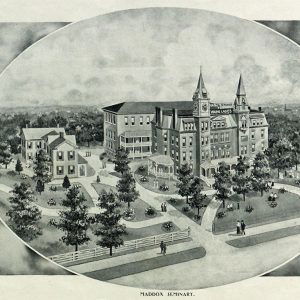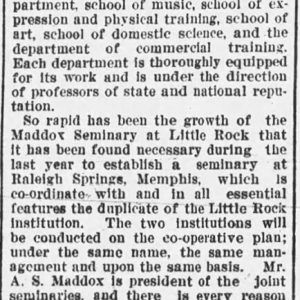calsfoundation@cals.org
Maddox Seminary
In 1898, the Reverend Alvin Stewart Maddox established the Maddox Seminary for young women in Little Rock (Pulaski County). The school lasted less than a decade before closing, with Maddox relocating to Eureka Springs (Carroll County), where he opened Crescent College in 1908.
In the summer of 1898, yellow fever was raging in Mississippi, where Maddox was serving as the president of the Union Female College of Oxford, a position he had held for four years. He was planning for the fall semester at the college, had hired faculty, had had a catalog printed, and was traveling the state promoting the college. Some students had already committed to enroll, but while he was away from Oxford, the town was quarantined, leaving him with no place to hold classes.
By September 1898, Maddox had leased the property at 1500 Lincoln Ave. in Little Rock. This site, a two-story mansion complete with stables, servants’ quarters, and pastures, had been owned by Governor Powell Clayton from 1868 to about 1882. Maddox also leased a four-story brick building that had once housed Little Rock University. By October 12, he was able to open the school, originally under the name Little Rock University. Enrollment was limited to female students only in the higher grades, but he accepted boys twelve and under as day students in the preparatory grades. He made arrangements in private boarding houses for female students. He promised that the faculty would help the students catch up for the delay in opening and finish the semester with the required number of lessons. In preparing for opening that fall, Maddox and his brother, Finis Ewing Maddox, moved into the mansion on the grounds. His brother was appointed vice president of the college.
The four-story brick building had two towers, with a clock in one. It was located on a high bluff overlooking the Arkansas River, having been built in 1883, with the major funding of $40,000 supplied by the Freedmen’s Aid Society and the Board of Education of the Methodist Episcopal Church located in Cincinnati, Ohio; in 1888 the name was changed to the Freedmen’s Aid and Southern Educational Society. Local contributions were $10,000. As the building was getting older and space was becoming scarce for boarding students, Rev. Maddox made a trip in the spring of 1899 to Cincinnati to request funds, and the society give him money for a three-story annex, as well as repairs and improvements to the main building. By the June 1899 graduation exercises, the school was named the Maddox Seminary.
By August, the Arkansas Gazette carried the announcement that a $300 scholarship was being offered covering the 1899–1900 academic year for an out-of-town girl. The winner would be determined by votes submitted to the Gazette by September 1. Local businessmen offered the winner additional items such as a piano, a scarf, and shoes—and a dentist promised free dental care. The scholarship contests continued each year the seminary operated in Little Rock, but over the years the amount was increased to $450 for first place, while second and third places were added for lesser amounts.
On September 3, the Gazette carried a glowing account about the changes made to Maddox Seminary, reporting that the enrollment was the largest experienced by any school for young women that had been in Little Rock before. The article described the excellent prospects for the school and the various courses offered, recommending that people support it. Maddox stated that the school now had room for all boarding female students on campus. He also reported that the school was non-denominational but would be conducted in a Christian manner.
By the fall semester of 1902, Christopher Columbus Cline had been hired as principal and one of the instructors. His three daughters were hired for the music department: Effie Maud and Sarah were trained in voice and elocution, and Martha Mae taught piano and organ. The college was now advertised as Maddox Seminary and Conservatory of Music. A separate part of the campus was converted to the conservatory. The daughters stayed only one or two years, but Cline remained longer.
Clarence W. (C. W.) Maddox, younger brother of Rev. Maddox, joined the staff as secretary and treasurer around 1902. The seminary was converted to the Maddox Summer Hotel in 1903 for the summer months, with C. W. Maddox as the manager. Rev. Maddox announced in April 1903 that he was starting a branch college at Raleigh Springs near Memphis, Tennessee, in the Raleigh Inn, to open in September 1903. He served as president of both colleges and manager of the Tennessee campus, while Finis Ewing Maddox was vice president and manager of the Little Rock campus. The catalog for 1903–1904 for both campuses came out that summer, with pictures of all forty staff members and the names of all past graduates of the Little Rock campus. In the class of 1899, there were five graduates receiving degrees; the next two years saw ten graduates apiece, followed by eight in 1902 and sixteen in 1903. There was an active alumnae association.
The Gazette of September 8, 1903, listed the educational offerings: a collegiate department, school of music, school of expression and physical training, school of art, school of domestic science, and department of commercial training. Each department was said to be thoroughly equipped and under the direction of extensively trained professionals. In 1905, Finis Ewing Maddox left to accept a pastorate at the First Presbyterian Church of Texarkana (Miller County), and Cline was named vice president of the seminary. In the winter break of the 1905–1906 school year, Clarence W. Maddox also left for Texarkana.
The 1906 June graduation exercises were a weeklong affair, and fifteen young women received diplomas, but Maddox was worried about funding, which was always a problem. He had made more than one trip to Cincinnati for funds. Local citizens said they wanted the seminary but were slow to make contributions. Next, the Freedmen’s Aid and Southern Education Society announced they were going to only support African American schools and, in July 1906, sold the campus at 1500 Lincoln Ave. to a group of Little Rock physicians. Maddox insisted that he was going to find a place for the seminary to reopen in Little Rock, but he was unable to secure a good location, and his next educational venture was opening Crescent College in Eureka Springs in 1908.
For additional information:
“Fragments of the Passing Years.” Arkansas Gazette, April 4, 1965, p. 70.
“Maddox Seminary Property Sold.” Arkansas Gazette, July 13, 1906, p. 3.
Maddox Seminary Yearbook, 1903–1904. BC MSS 08.17. Butler Center for Arkansas Studies. Central Arkansas Library System, Little Rock, Arkansas. http://purl.oclc.org/arstudies/bc-mss-0817 (accessed April 29, 2024).
Nashville News (Nashville, Arkansas), October 8, 1898, p. 2.
“Raleigh Springs and the Raleigh Inn and the Maddox Seminary, and the James Sanitorium.” Historic Memphis. https://historic-memphis.com/memphis/raleigh-inn/raleigh-inn.html (accessed April 29, 2024).
“School Days O’er.” Arkansas Gazette, June 8, 1899, p. 2.
Yazoo Herald (Yazoo City, Mississippi), June 24, 1898, p. 3.
Carolyn Yancey Kent
Jacksonville, Arkansas


 Maddox Seminary
Maddox Seminary  Maddox Seminary Ad
Maddox Seminary Ad  Maddox Seminary Story
Maddox Seminary Story 



Comments
No comments on this entry yet.